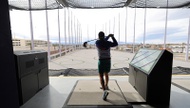
Perimeters Through November 13; Monday-Friday, 8 a.m.-5 p.m. Clark County Government Center Rotunda Gallery, 702-455-7030.
There’s no Mojave Desert in Rebecca Pugh’s sculptures. No pictures of sand dunes, no actual piles of sand, no maps or souvenirs of barbed wire. The materials—bed frames and found fabric—have nothing to do with the desert. The horizontal and vertical lines in the sculptures have little relation to the organic rise and fall of rocky hills and plains on the outskirts of Las Vegas. But this is just where it gets weird—because the Mojave pulses in Pugh’s Perimeters exhibition at the Government Center Rotunda Gallery.
The five free-standing sculptures look, at first, like looms—the twin, double and queen-size bed frames wrapped in strips of fabric. They can just as easily be seen as windows, sporting the familiar blinds found in many Las Vegas homes—stripes of fabric instead of wooden slats, the view seeping in through cracks. On closer inspection, delicacy becomes apparent in the carefully frayed edges, the loose threads, the transparency of the weave. Some of the strips of fabric dangle their loose ends; others are tucked tightly around the wooden posts. Four of the works feature horizontal lines, the fifth vertical. Rather than being displayed on pedestals, the sculptures sit directly on the floor.
With their prevalent stripes, commercial materials and banished pedestals, Pugh’s sculptures might be mistaken for a textbook recap of Minimalist art. Are they chastised Donald Judds? Crafty outtakes from a geometric Frank Stella canvas?
Neither. While Minimalism generally sought to deflect illusion and metaphor, Pugh’s works are made to invoke the desert. The palette of worn and faded fabrics, culled from used-clothing stores, recall the subtle range of color in the Mojave, particularly at the end of the day when the light lengthens and shifts toward the red end of the spectrum. The stripes have less to do with the man-made geometries of urban design than with geological stratification. And finally, the fragility of these artworks—wooden bed frames that can easily topple, fabrics that can easily soil—is a reminder of the desert’s fragile habitat.
The fragility that is Perimeters’ strength is also its Achilles’ heel. Industrial stanchions with retractable plastic belts herd the works into the center of the busy Rotunda Gallery. Protecting the art from damage is one thing; damaging its power while protecting it is another. Pity that another solution was not found. The sculptures are, finally, like the desert itself: mostly looked at from afar.






